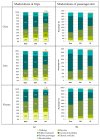Evaluating Health Co-Benefits of Climate Change Mitigation in Urban Mobility
- PMID: 29710784
- PMCID: PMC5981919
- DOI: 10.3390/ijerph15050880
Evaluating Health Co-Benefits of Climate Change Mitigation in Urban Mobility
Abstract
There is growing recognition that implementation of low-carbon policies in urban passenger transport has near-term health co-benefits through increased physical activity and improved air quality. Nevertheless, co-benefits and related cost reductions are often not taken into account in decision processes, likely because they are not easy to capture. In an interdisciplinary multi-model approach we address this gap, investigating the co-benefits resulting from increased physical activity and improved air quality due to climate mitigation policies for three urban areas. Additionally we take a (macro-)economic perspective, since that is the ultimate interest of policy-makers. Methodologically, we link a transport modelling tool, a transport emission model, an emission dispersion model, a health model and a macroeconomic Computable General Equilibrium (CGE) model to analyze three climate change mitigation scenarios. We show that higher levels of physical exercise and reduced exposure to pollutants due to mitigation measures substantially decrease morbidity and mortality. Expenditures are mainly born by the public sector but are mostly offset by the emerging co-benefits. Our macroeconomic results indicate a strong positive welfare effect, yet with slightly negative GDP and employment effects. We conclude that considering economic co-benefits of climate change mitigation policies in urban mobility can be put forward as a forceful argument for policy makers to take action.
Keywords: air pollution; climate change mitigation; health co-benefits; interdisciplinary approach; physical activity; urban mobility.
Conflict of interest statement
The authors declare no conflict of interest.
Figures












References
-
- Mueller N., Rojas-Rueda D., Basagaña X., Cirach M., Cole-Hunter T., Dadvand P., Donaire-Gonzalez D., Foraster M., Gascon M., Martinez D., et al. Urban and Transport Planning Related Exposures and Mortality: A Health Impact Assessment for Cities. Environ. Health Perspect. 2016;125 doi: 10.1289/EHP220. - DOI - PMC - PubMed
-
- Perez L., Trüeb S., Cowie H., Keuken M.P., Mudu P., Ragettli M.S., Sarigiannis D.A., Tobollik M., Tuomisto J., Vienneau D., et al. Transport-related measures to mitigate climate change in Basel, Switzerland: A health-effectiveness comparison study. Environ. Int. 2015;85:111–119. doi: 10.1016/j.envint.2015.08.002. - DOI - PubMed
-
- Haines A., McMichael A.J., Smith K.R., Roberts I., Woodcock J., Markandya A., Armstrong B.G., Campbell-Lendrum D., Dangour A.D., Davies M., et al. Public health benefits of strategies to reduce greenhouse-gas emissions: Overview and implications for policy makers. Lancet. 2009;374:2104–2114. doi: 10.1016/S0140-6736(09)61759-1. - DOI - PubMed
Publication types
MeSH terms
Substances
LinkOut - more resources
Full Text Sources
Other Literature Sources
Medical
Miscellaneous

